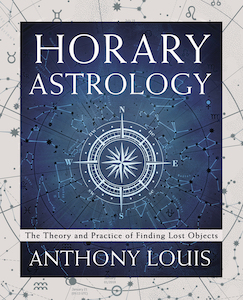
Horary Astrology: The Theory and Practice of Finding Lost Objects, by Anthony Louis
Llewellyn Publications, 0738766997, 424 pages, February 2021
We’ve all been there: frantically search for our lost keys, precious jewelry, or important document. Often we’ll start grumbling about how “it must be somewhere” or perhaps say a quick prayer to beloved St. Anthony, finder of lost objects. But did you know that you can also use astrology to find what’s been lost?
Horary astrology is the art of answering questions by casting a chart based on the exact time the astrologer receives the question. When you’ve run out of options and finally decided to ask for guidance by casting an astrological chart, it can reveal the answer if one knows the techniques to interpret the chart.
In his book Horary Astrology: The Theory and Practice of Finding Lost Objects, Anthony Louis takes readers into a deep dive of this ancient art and provides a wonderful foundation for budding learners. Loaded with real-life examples and extremely detailed explanations of how to read horary charts, Horary Astrology is a wonderful starting point for a seasoned astrologer who hopes to further their knowledge in this branch of astrology.
I do emphasize seasoned though, because this book would most likely be a bit overwhelming for the novice astrologer. Though Louis provides thorough explanations of all his material, I think it’s worth noting the first chart of the book is featured on page eight, which pretty much indicates Louis isn’t giving us the background on how to read charts and we’re going right into things.
You should absolutely be familiar with the houses, zodiac signs, and planetary significance before diving in, though Lous does further explain much of this in regard to reading the chart from a horary perspective. For instance, there is a chapter “Houses and the Human Body,” and another “The Twelve Signs and Associated Physical Locations.” The chapter “The Signs” provides the indoor location related to each zodiac sign, along with possible locations based on the element of the sign.
The majority of the book draws from seventeenth-century astrology William Lily, most noted for his work Christian Astrology. This would be a great read for someone who wants to learn the techniques of Lily without delving into his few-hundred-year old work, as Louis is constantly referring to Lily throughout the whole book. For instance, Louis writes about via combusta, “which, according to Lilly, is an unlucky region from 15 libra to 15 Scorpio where the two Luminaries pass through the signs of their “dejection” or “fall,” implying a deprivation of solar and lunar light…”1 This is just one example of how Louis imparts Lilly’s wisdom into his own work and informs the reader in the process that I found immensely useful.
As for the examples of horary Louis provides, they are varied and absolutely fascinating! From missing people to garage door openers, I felt like I was a detective on a search in reading what was missing, and then I was absolutely thrilled to read how Louis pieced together the clues within the horary chart to solve the case. It really gave me a clear understanding of the application of the techniques Louis writes about in the first half of the book. The examples provided do a wonderful job of explaining his chart interpretation to answer the proposed question or locate what’s missing that really lay out Louis’s thought process.
Another chapter I really enjoyed was “Plantary Keywords of Vettius Valens (C. 175 CE) where Louis shares lists of planetary keywords based on the work of second-century Hellenistic astrologer Vettius Valens. I think for someone who wants to engage in this type of astrology work, these keyword lists are very influential in being able to decipher the messages of the chart. However, the keywords also bring up my personal dislike for outdated associations with all the planets.
For instances, keywords of Saturn are “self-deprecating,” “downcast,” “tears and grief,” “unemployment,” and “childlessness” to name a few. Maybe I’m too modern for Hellenistic astrology, but I feel the associates can be very outdated, keeping the planets trapped in stereotypes with little room to expand. This is useful in horary astrology perhaps, which uses these keywords to solve real world problems, but I think it can hinder the greater impact of the different planets’ role in our expression.
This isn’t a book I was able to digest easily, and I certainly had to take it piece by piece. It is something that one would absolutely refer to time and time again, making it a worthy investment for a serious student. However, if one is just looking for a brief introduction or beginner’s guide to horary, this is definitely beyond that scope.
The next time you’re struggling to find something that’s lost, hopefully you’ll remember Horary Astrology. Maybe you’ll learn to decipher if it’s possible to find what’s lost, and if so, where it might be located. Taking on this practice will definitely make you feel like a detective. Louis’s insightful writing will deepen your understanding of how our daily life and the stars are so intimately connected, as long as you can see the clues. Though it’s not a light study, the rewards seem rich, which has kept this ancient art a worthy pursuit all the way to modern times.
Alanna Kali is an astrologer, numerologist, and pioneer spirit that loves to explore life through the lens of depth psychology. She has a passion for studying the humanities and social trends. Her academic work is centered upon reuniting body, mind, and spirit through eco-psychology. She loves reading, spending time in nature, and travel.
